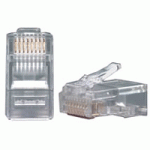RG-6 cable is one of the more common types of coaxial cables used for commercial and household purposes. The term RG-6 is a generic label that can be used to describe a whole range of cable designs. In fact, all cable designs described under RG-6 may well differ from one another in center conductor composition, dielectric type, or shielding characteristics. RG-6 was originally a military specification meaning Radio Guide, but this term has become obsolete due to lack of use. Today it is used to describe coaxial cables with 75-ohm Read More
Plenum Cable
The plenum is hidden space within a building which is used for HVAC (Heating, Ventilation, and Air Conditioning) and to run cables. Plenum space is normally above a suspended ceiling or under a raised floor. Buildings without plenum spaces will have cabling and HVAC ducts within plain view. The plenum space is normally used to accommodate the communication wires for the building's computer and telephone network. Recent studies have shown that wiring and cabling within the plenum space could be dangerous and be exposed to fire/burning possibilities. Plenum cable is Read More
UTP (Unshielded Twisted Pair)

UTP (Unshielded Twisted Pair) is a regular copper wire that joins many home and many business computers to the telephone company. UTP is the most common form of twisted pair wiring, because it is less expensive and easier to work with than STP (Shielded Twisted Pair). It is used in Ethernet 10Base-T and 100Base-T networks as well as in home and office telephone wiring. Two insulated copper wires are twisted around each other to decrease crosstalk or electromagnetic induction between pairs of wires. The twist in UTP helps to reduce Read More
RJ-45

RJ-45 is the standard connector utilized on 4-pair (8-wire) UTP Unshielded Twisted Pair) cable. It is generally implemented for network and telephone cabling. Sometimes, it's also utilized for serial network connections. The RJ-45 connector is the standard connector for 10Base-T/100Base-TX Ethernet, ISDN, T1, and modern digital telephone systems. Standard RJ-45 pinouts describe the arrangement of the individual wires required when connecting connectors to a cable. RJ-45 connectors appear similar to the RJ-11 connectors utilized for connecting telephone equipments, but they are a bit wider. RJ-45 stands for "Registered Jack – Read More
Cable Stapler
A cable stapler (cable tie gun) is a mechanical device that is used to secure cables, wires, and other cords. Cable staplers are often used in the construction industry to secure cables during construction and to properly install outlet wires. Cable staplers are also used to bundle rope, twine, straps, and similar materials during transportation to protect valuable materials, as too much movement may damage them. Cable staplers work by mechanically fastening a strap much tighter than any human could ever do. Cable Stapler VS Regular Stapler While regular staplers/staple Read More
Network Card
A network card is an expansion card that installs into a computer and enables that computer to physically connect to a local area network. The most common form of network card in current use is the Ethernet card. Other types of network cards include wireless network cards and Token Ring network cards. Ethernet network cards most often use RJ-45 jacks. Wireless network cards usually have no external connections other than a possible antenna jack. Other terms for network card include network adapter, network interface card, and NIC. Network Card Interfaces Read More
RG-59
The RG-59 cable is a type of coaxial cable that is used to generate low-power video connections. The cable works on two conductors that are based on a single common axis. It is also used for RF signal connections. The RG-59 cable conducts video and radio frequencies at an impedance of around 75 ohms. The RG-59 cable is used for generating short-distance communication. The cable can be used at baseband video frequencies, which is measured from the lowest count of zero and continues to the highest signal frequency. Baseband refers Read More
RG-8
RG-8 is a 50-ohm coaxial cable that is used for radio transmission (for instance in amateur radio or CB). Recently, they have become an integral part of computer networks, as they can increase connectivity. One of the first things that someone will notice about RG-8 cables is that they are huge when compared to other cables. Since they are 50-ohm cables, they cannot be used for any kind of video work. They are composed of dielectrics, center conductor materials and the jackets surrounding them that provide protection from external harm. Read More
Patch Cables
Patch cables act as a patch, making an electrical or optical connection between different devices. There are many different types of patch cables, and they are usually quite short, anywhere from a few inches to several feet in length. Although they can be called patch cables, they each perform a specific function based on how they are made. A coaxial cable that connects from the wall jack to your cable television set-top box is an example of a patch cable. That cable is only useful for bridging coaxial connections (or Read More
N Connectors
The Type "N" connector, commonly known as the N connector, is used to join coaxial cables using a threaded RF connector. It was one of the first connectors to be capable of carrying microwave-frequency signals. Invented by Paul Neill of Bell Labs in the 1940s, the connector is named after him. Design Details These connectors were devised to carry signals that could reach 1 GHz in certain military applications. The Type N connector that is commonly used today can easily handle up to 11 GHz. However, that was just the Read More


Share on: